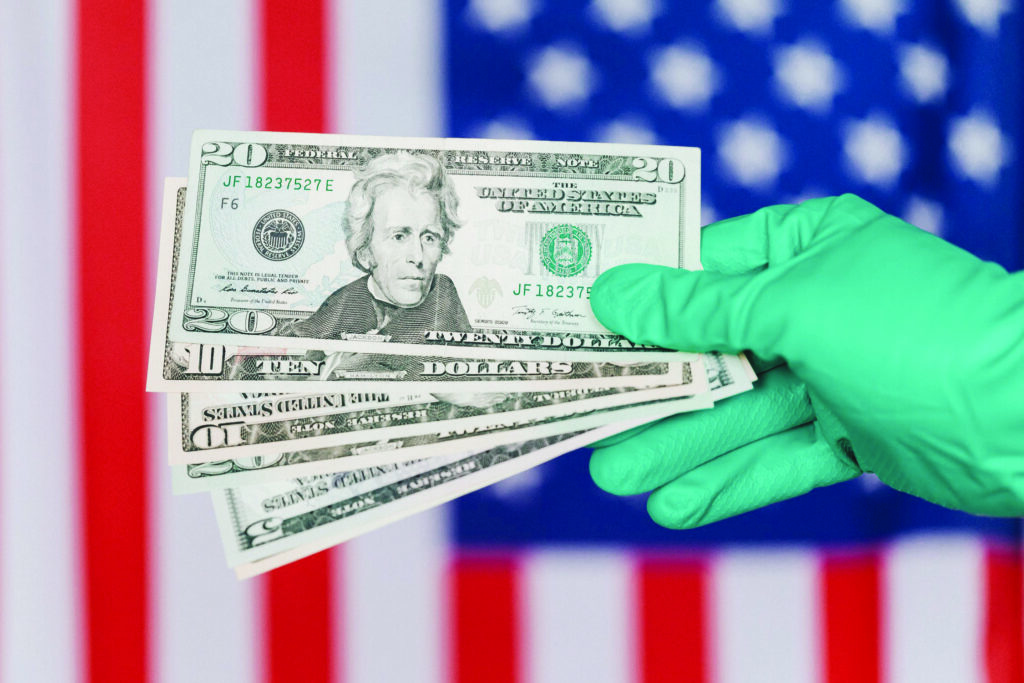The COVID-19 pandemic taught our country a harsh lesson, but an essential one – India’s healthcare system has been deeply flawed for ages, and it’s high time it got treated
By Abhijit Chanda
- The Indian healthcare system is not only fractured, it is fragmented
- Doctors who manage to get trained often use it as a ticket to leave the country for greener pastures like THE UK, US and Canada
- The number of hospital beds are miserably low for the population they cater to
- The government has been trying to tackle this problem by providing budgets to states to open up more seats in medical colleges
DURING the pandemic, the availability of hospital beds was heartbreakingly low. Ventilators, oxygen concentrators and oxygen tanks were being traded on WhatsApp groups and in the black market. Doctors were being worked to death, literally, with many catching covid and others committing suicide.
We must keep in mind that the pandemic itself isn’t to blame. The country’s healthcare infrastructure has long had these fractures that led to it crumbling when the pandemic hit. There are several aspects to the flaws in the infrastructure, from the education of aspiring doctors to the difficulties of creating a network that can cater to 138 crore people, many of whom live in the deepest rural corners of our country.

However, this isn’t an article made to disparage the doctors, nurses, medical personnel and hospitals in this country, who we should be applauding for their unyielding determination to help everyone they can. This is to shine a light on these shortcomings, so we can use our voices and our votes to influence change and help India become healthier.
And one last thing – this is only the tip of the iceberg.
The First Fracture: Medical Education
At the very root of the problem is the scarcity of doctors in India. We currently have an optimistic estimate of 0.8 doctors per 1000 people, (the data here is a highly contentious estimate) which still doesn’t touch the minimum number of doctors to patients recommended by the WHO, which is 1:1000. The government aims to achieve this by 2024, according to Dr Vinod K Paul, Member, NITI Aayog, at CII Asia Health 2021.
There are significant problems along the way, though. Medical colleges offer very few seats compared to the number of applicants. Only around 15,000 seats are available in various government institutes every year against more than 5 lakh aspirant doctors. On the other hand, private colleges often charge exorbitant fees – from Rs 30 lakhs to over 50 lakhs. This leaves many students out in the cold, with no way to turn except alternative medicine colleges or cheaper colleges abroad in China, Russia, Ukraine, the Philippines, and Nepal.
Dr Shantanu Abhyankar, MD, MBBS, ObsGyn in Wai, Maharashtra, started off studying homoeopathy before leaving it to pursue a medical degree. He told me in an interview, “When they (medical aspirants) could not get into modern medicine, they (alternative medicine courses) are looked upon as a backdoor entry to modern medicine. They are very intelligent students, and they do well in their practice. They work in so many different fields and try to fill up niches which are left empty in the current system.”
Medical colleges offer very few seats compared to the number of applicants. Only around 15,000 seats are available in various government institutes every year against more than 5 lakh aspirant doctors. On the other hand, private colleges often charge exorbitant fees – from Rs 30 lakhs to over 50 lakhs
He went on to say, “The government of Maharashtra has a bridge course where, after a few months of training, people who have qualified as homoeopaths can practise [in] modern medicine, but with a limited armamentarium of drugs. The government has public health in its mind, and it seems that it is the Ayurvedic and homoeopathic practitioners who reach the far-flung areas and villages, and they are the ones who are providing health services to the downtrodden.”
The doctors who manage to get trained often use it as a ticket to leave the country for greener pastures like the UK, US, Canada and others. This leads to better standards of living and better pay, and more humane conditions than Indian government hospitals. For instance, in 2017, more than 15,000 doctors completed their studies in medicine in India and are now in the NHS, UK. And, by early 2019, Indians represented a majority among non-British nationalities for NHS staff.
The government has been trying to tackle this problem by providing budgets to states to open up more seats in medical colleges. The implementation, though, hasn’t been encouraging. In 2019, an RTI was filed by Chandra Shekhar Gaur, a resident of Madhya Pradesh who knows the status of medical seats in the country and compared what was promised with what was delivered. A massive shortfall in implementation was exposed as many of the states who had been allocated budgets for increasing the number of seats didn’t deliver. For instance, the RTI stated that Andhra Pradesh and Rajasthan got only 50 new MBBS seats instead of the approved 150 and 350 seats. In Karnataka, 550 MBBS seats were approved, but only 350 have been created. And in states like Jharkhand, Madhya Pradesh, Tamil Nadu, Uttarakhand, West Bengal, and Manipur, not a single seat has been added.
Unless we can drastically change the scenario at the grassroots level by making quality medical education available to more people, especially those from underprivileged sections of society, and then ensure their pay and working conditions are more sustainable, we have little to no chance of having the human resources needed to create a healthcare infrastructure for over 1.3 billion people.
Infusion of technology for faster recovery: PPP for innovation and telemedicine

ONE of the biggest problems in rural healthcare is the lack of inexpensive diagnostic equipment that state governments can afford and local healthcare workers can operate efficiently and effectively.
The Indian Government’s Council of Scientific and Industrial Research (CSIR) started the New Millennium Indian Technology Leadership Initiative (NMITLI). Through this initiative, they are being a catalyst for private companies to create groundbreaking technology in various fields, with healthcare being one of them.For instance, by partnering with a company called Bigtec, a new Micro-PCR machine, called TrueLab, has been developed that is a fraction of the cost and the size of an RT-PCR machine that we have now become familiar with. It can run blood samples and diagnose various infections in just 20 minutes.
Similarly, GE’s Mac 400 ECG machines, MobileLab (an entire diagnostics lab in a suitcase) and LaBike (a lab that can be transported on a motorcycle) are all innovations that can help basic diagnostics into deep villages. They are still to be widely adopted, but hopefully, the future will see them spread into the further reaches of the country.As you can see, the Indian healthcare system is not only fractured, it is fragmented. There are schemes and missions galore, but there doesn’t seem to be a coordinated push to overhaul this network.
With PPP initiatives, far more investment into the healthcare system and strict regulations and implementations, India can still see a marked improvement over the next decade or two. But millions of us don’t have that much time. We are still in the clutches of a deadly pandemic washing away lakhs of lives with each wave. All we can do is invest in NGOs and companies doing good work and vote for parties that are seriously focused on helping rid our country of the complacency and carelessness that has ravaged our ailing healthcare system.Infected Wound: Condition of Indian Hospitals
Speaking of working conditions, the government hospitals in India are primarily abysmal. Let alone the standards not being up to the mark, they are often stomach-turning and inhumane.
A patient at Moradabad District Hospital told ANI, “Sanitation workers do not change the bedsheets, patients have to sleep on dirty and stained sheets. They clean the room once every two or three days and charge every patient for cleaning their room.”
The 2022 Union Budget did bring up the government’s investment in healthcare with INR 82,920 crores, up by just 0.1% from the previous year’s revised budget. This money is being funneled into some of the right places like expanding medical education, setting up new AIIMS

The beds are often rust-eaten with dirty bed sheets and mattresses, the toilets in many hospitals seem like they haven’t been cleaned in ages with old plumbing that often falls apart flooding wards. The wards themselves are often rat and pest-infested, some have even been reported to let in stray dogs and cats. Sights like cobwebs and paan spit on the walls are all too common. Adding to this, the number of hospital beds are miserably low for the population they cater to. Dr Vinod K Paul from NITI Aayog continued, saying, “Firstly, in infrastructure, we currently have 12 lakh beds, half in the private and government sector. “The national health policy expects us to increase the ratio of 1:1000 to 2:1000. We are truly short of beds, and we should eventually pitch for 3:1000 given that we will have a large [population of] senior citizens coming up who will need hospitalisation,” said Paul.
The Disease Spreads: Rural Healthcare
India’s rural public health system has a tiered structure. At the bottom are sub-centres, catering to populations of 3,000 to 5,000, or around five villages. Then there are primary health centres (PHCs), which are the first tier where doctors are based and act as the system’s core. They act as referral units for up to six sub-centres. PHCs then flow into community health centres (CHCs), which in turn refer to sub-district and district hospitals. At the top are medical colleges and advanced research institutes like the All India Institute of Medical Sciences (AIIMS).
It all makes sense until we look more closely at how it is all implemented. National surveys have shown that less than half of the households in each of these regions reach out to government medical institutions thanks to the poor healthcare quality (as we have spoken about earlier), along with the distance they have to travel by foot, bullock cart or whatever other transport they can get onto, and the long lines they have to sit in once they reach there.
Put yourself in a position, imagine when you are ill, without having access to ambulances, cabs, cars or even bikes. You have to travel by foot, bullock cart in the scorching heat. And once you reach the medical centre, you will see a building that looks far from a place of healing. Wouldn’t you prefer to turn back to the comfort of your loved ones?
Put yourself in their positions and imagine such a journey when you are ill, without having access to ambulances, cabs, cars or even bikes. You have to travel by foot, bullock cart or hitch a ride on a bike or rickshaw in the scorching heat. And once you reach the medical centre, you will see a building that looks far from a place of healing. Wouldn’t you prefer to turn back to the comfort of your home and loved ones? Indeed, the proportion of these centres that meet the Indian Public Health Standards are miserably low – 11% of the sub-centres, 13% of PHCs and 16% of CHCs.
In the villages, three primary parties care for the ailing. They have only basic medical training in a small range of ailments:
Accredited Social Health Activists (ASHA):
These women are literate, aged between 25 and 45, elected by the village and accountable to it as an interface between the community and the public health system. They create awareness of health and provide the rural population with access to health services.
Auxiliary Nurse Midwife (ANM):
These female health workers are based at health sub-centres or primary health centres, primarily focusing on essential maternal health, including midwifery and child health along with family planning, immunisation, infectious disease prevention and care.
Anganwadi:
Anganwadi is a type of child and mother care centre established as a part of the Integrated Child Development Scheme (ICDS). The Anganwadi worker is in charge of managing the Anganwadi.
These are all attempts to extend the healthcare system’s reach into deep villages. Unfortunately, many such workers don’t get the training and support they need to be as effective as possible. Even when they manage to get the ailing to PHCs, they still have to wait forever for doctors to attend to them in often horrible conditions. Until the rural infrastructure is adequately brought up to at least Indian Public Health Standards with more doctors, nurses and other personnel to handle our massive population, little can be done for most of our country folk.
The Hope For a Cure: The Budget
The 2022 Union Budget did bring up the government’s investment in healthcare with INR 82,920 Crores, up by just 0.1% from the previous year’s revised budget. This money is being funnelled into some of the right places like expanding medical education, setting up new AIIMS, research, developing medical infrastructure, etc.
However, in my humble opinion, the government should be pumping a lot more money into the healthcare sector and also ensuring every paisa is being spent correctly. There also needs to be a significant overhaul of how the public health standards are being implemented in government hospitals. The mind boggles at the ineptitude of such hospitals and why they simply don’t care about the health and safety of their patients.
Whirlpool of Uncertainty

How on earth can the already struggling medical education infrastructure accommodate a sudden influx of over 18,000 students?
UKRAINE was home to around 18,000 Indian students, many of them are medical students who have been flocking to the country, attracted by their government universities’ incredibly affordable educational costs.
Don’t let any preconceived notions trick you – these are high-scoring, smart students from middle-class families. The terrible combination of limited government medical school seats, unrealistically high cut-offs and exorbitantly expensive private colleges lead these aspiring doctors to look beyond our borders for quality medical education. In Ukraine, they can get exactly that, including the cost of living and travel, at a fraction of the cost of private Indian colleges.
When the Russian attacks started, thousands of these students managed to return to India. However, many were stranded in cities like Kyiv, Kharkiv and Sumy. Videos started surfacing on social media from students sheltering in hostels and bunkers, suffering from sub-zero temperatures and shortages of food and water, some pleading with the Indian government to help them evacuate, others frustrated at the lack of response from the personnel in the Indian embassy.
As the shelling continued, an Indian student, Naveen Shekharappa Gyanagoudar, was killed by Russian shelling. His story went viral, forcing us to all realise how dire the situation really was. His story, along with those of the other stranded students, went viral across social media and international news channels. Almost 700 students from Sumy, and thousands from other cities, have now successfully been returned to their families. However, their futures are still painfully uncertain.
How on earth can the already struggling medical education infrastructure accommodate a sudden influx of over 18,000 students?
First-year medical students don’t have too much of a problem if at least 120 of the 296 private medical colleges in India can accept 150 students each. This year is primarily theoretical with pre-clinical subjects being taught. Most colleges should be able to accommodate that bandwidth.
However, the problems start with the second year, when clinical studies begin. Large, busy government hospitals can be ideal training grounds for such students if private colleges agree to collaborate with them.
Additionally, many colleges and educational hospitals will have to construct bigger classes, laboratories and auditoriums, and nearly double some of their capacity, leading to expenses in the hundreds of crores. Will they still remain as affordable to students as the universities in Ukraine? And most importantly, how many of these private colleges would be willing to even make the effort?
These massive changes won’t happen overnight, and they certainly won’t happen without mandates and regulations from the central government. Colour me cynical, but seeing how tight-fisted they have been so far, I don’t see that as a realistic expectation. From my perspective, the future for these students returning from Ukraine doesn’t seem bright at the moment. But their stories are being shared across the world. We too can stand up for them by pleading and petitioning the government to do the right thing and overhaul the medical education infrastructure on the double, not only for these students but for the health of the whole nation.
